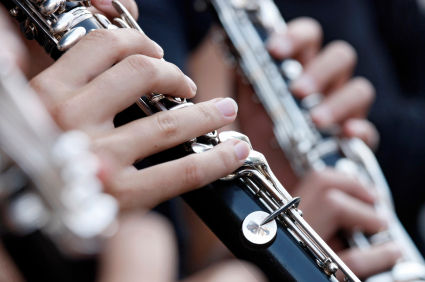 |
Monday, April 29, 2013
Palen Music Center is dedicated to helping children experience excellence, personal growth, and joy through involvement in music. We carry out this mission by supporting area band directors through weekly service, support, educational programs, and quality products. This weekly Quick Note newsletter strives to highlight topics that are immediately helpful in the classroom. Comments, suggestions, ideas, and articles are always welcome.
Looking for help on a particular topic? Be sure to check out our Quick Note Catalog of back issues! |
 |
Beginning Clarinet Articulation and Section Tuning
I am forever puzzled by the students who use their throat or air alone at the beginnings of notes. I have come up with a method that has proven to be very effective when teaching basic articulation to the masses. My beginning clarinet classes average about 40. This year I have four beginning clarinet classes. If Iím not proactive when it comes to tonguing, some students may slip through the cracks and develop bad habits. And as we well know, those habits are difficult to break and replace with good habits. I call the method ďMorse codeĒ tonguing. I explain and demonstrate where the tongue touches the reed using the common tip-to tip idea. We talk about 3 taste buds at the tip of the tongue striking the tip of the reed. After an explanation (using as few words as possible and always repeating the same terms), I demonstrate by tonguing as randomly as I can. I begin by tonguing quickly and demonstrate slow random tonguing as well. There is no pattern, set rhythm, or meter. I donít mention eighth notes or sixteenth notes. A Morse code effect is heard. I have my students do the same. Contrary to how weíve been taught as players and educators, I encourage my kids to tongue as quickly as possible. We donít begin the process slowly and gradually increase tempo. They tongue quickly and randomly making sure they are touching the tip of their tongue to the reed. It is loud and obnoxious and thatís OK! There is absolutely NO time for inaccurate tonguing to occur when this exercise is executed. They also immediately become aquatinted with the ďfeelĒ for how to articulate which encourages correct muscle memory. After doing this exercise for a bit of time both as a class and individually, we play straight quarter notes in succession. This too is done at a fast clip. (between 112 and 120 bpm) Now the students know and understand how to tongue; and more importantly know how it feels. They have NEVER huffed or throated a note, so that particular physical sensation is foreign to them. Initially, we practice Morse code every day on mouthpiece and barrel until tonguing is natural and correct. This has made all the difference in teaching a large groups accurate tonguing. Fortunately, I have not encountered huffing or throating since. Section Tuning Before tuning is discussed, some assumptions should be made. A working instrument, playable reed and excellent air support will be key in any tuning situation. I encourage our clarinets to tune their open G and third space C in our concert bands. I donít believe this is breaking news to most band directors. What I have noticed however is (especially in young players) that students are hesitant to make adjustments on their instruments. Adjustments for the open G should be made by pulling out or pushing in the barrel. Encourage your students to over-adjust. Many might hear the tuning discrepancy, but if an adjustment isnít made on their instrument and the director doesnít insist it happens, then tuning is futile. The third space C on clarinet should be adjusted by pulling out or pushing in the middle of the instruments at the bridge. Again, students may over-compensate, but I find this to motivate the students to be more proactive in tuning and helps them realize how much control they have in the tuning process. Mary Lollis Mary is currently a middle school band director for Union Public Schools in Tulsa, Oklahoma. She is a member of the Tulsa Symphony Orchestra, Tulsa Opera Orchestra, Tulsa Starlight Band, Tulsa Clarinet Quartet, and the Council Oak Trio. Mary has been an adjunct clarinet instructor at Northeastern State University in Tahlequah, OK. and a band director for the Edmond and Jenks public school systems. |
 Articulation
Articulation